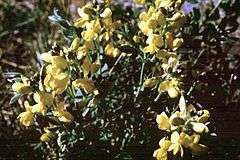Thermopsis rhombifolia
| Thermopsis rhombifolia | |
|---|---|
 | |
| Scientific classification | |
| Kingdom: | Plantae |
| (unranked): | Angiosperms |
| (unranked): | Eudicots |
| (unranked): | Rosids |
| Order: | Fabales |
| Family: | Fabaceae |
| Genus: | Thermopsis |
| Species: | T. rhombifolia |
| Binomial name | |
| Thermopsis rhombifolia (Nutt. ex Pursh) Nutt. ex Richardson | |
Thermopsis rhombifolia, also known as prairie thermopsis,[1] golden bean, buffalo bean, wet tooth, and buffalo flower, is a hardy perennial native to the North American plains.
A member of the pea family, it grows in grassland, hillsides, and patchy woodland areas to a height of about 30 cm, and produces bright yellow golden flowers about a centimetre long. The flowers were commonly used by the natives as a source of yellow dye and were boiled in a tea as a cure for stomach ailments for people and horses. The plant has toxic properties if ingested; symptoms of poisoning include vomiting, dizziness, and abdominal pain.
This plant is a beautiful addition to an early spring garden, but is extremely aggressive and must be contained.
References
- ↑ "Thermopsis rhombifolia". Natural Resources Conservation Service PLANTS Database. USDA. Retrieved 9 December 2015.
- ^ Stories and Spaces - Buffalo Bean Retrieved 25 April 2006
- ^ Case series of Thermopsis exposure Retrieved 25 April 2006
External links
| Wikimedia Commons has media related to Thermopsis rhombifolia. |
This article is issued from Wikipedia - version of the Thursday, December 10, 2015. The text is available under the Creative Commons Attribution/Share Alike but additional terms may apply for the media files.